|
|
|
|
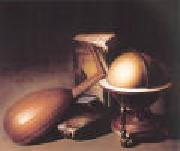 |
Gerrit Dou
|
|
1613-1675
Dutch
Gerard Dou Locations
Dutch genre and portrait painter of Leiden. The son of a glass painter, he was apprenticed to an engraver and worked from 1628 to 1631 in the studio of the young Rembrandt. Although he occasionally borrowed Rembrandt themes, he was more detailed and meticulous in his execution. His scenes of domestic, middle-class life were tremendously popular and often imitated. Among his most famous works are Evening Light (Rijks Mus.), Young Man (The Hague), The Cook (Louvre), and a self-portrait (Metropolitan Mus.). |
|
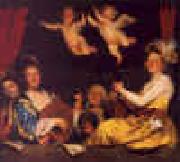 |
Gerrit van Honthorst
|
|
1590-1656
Dutch
Gerrit Van Honthorst Galleries
Gerard van Honthorst (November 4, 1592 - April 27, 1656), also known as Gerrit van Honthorst and Gherardo della Notte, was a Dutch painter of Utrecht. He was brought up at the school of Abraham Bloemaert, who exchanged the style of the Franckens for that of the pseudo-Italians at the beginning of the 16th century.
Margareta Maria de Roodere and Her Parents by Gerrit van Honthorst (1652) Oil on canvas, 140 x 170 cm. Centraal Museum, UtrechtInfected thus early with a mania which came to be very general in the Netherlands, Honthorst went to Italy in 1616, where he copied the naturalism and eccentricities of Michelangelo da Caravaggio. Home again about 1620, after acquiring a considerable practice in Rome, he set up a school at Utrecht which flourished exceedingly. Together with his colleague Hendrick ter Brugghen, he represented the so-called Dutch Caravaggisti. In 1623 he was president of his gild at Utrecht, where he had married his cousin. He soon became so fashionable that Sir Dudley Carleton, then English envoy at The Hague, recommended his works to the earl of Arundel and Lord Dorchester. In 1626 he received a visit from Rubens, whom he painted as the honest man sought for and found by Diogenes.
The queen of Bohemia, sister of Charles I of England and electress palatine, being in exile in the Netherlands, gave Honthorst her countenance and asked him to teach her children drawing; and Honthorst, thus approved and courted, became known to her brother Charles I, who invited him to England in 1628. There he painted several portraits, and a vast allegory, now at Hampton Court, of Charles and his queen as Diana and Apollo in the clouds receiving the duke of Buckingham as Mercury and guardian of the king of Bohemia's children. Charles I, whose taste was flattered alike by the energy of Rubens and the elegance of Van Dyck, was thus first captivated by the fanciful mediocrity of Honthorst, who though a poor executant had luckily for himself caught, as Lord Arundel said, much of the manner of Caravaggio's colouring, then so much esteemed at Rome. |
|
|
|
|
|
|
|
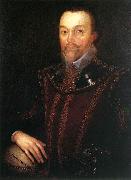 |
GHEERAERTS, Marcus the Younger
|
|
Flemish Baroque Era Painter, ca.1561-1636
was an artist of the Tudor court, described as "the most important artist of quality to work in England in large-scale between Eworth and Van Dyck" He was brought to England as a child by his father Marcus Gheeraerts the Elder, also a painter. He became a fashionable portraitist in the last decade of the reign of Elizabeth I under the patronage of her champion and pageant-master Sir Henry Lee, introducing a new aesthetic in English court painting that captured the essence of a sitter through close observation. He became a favorite portraitist of James I's queen Anne of Denmark, but fell out of fashion in the later 1610s. Marcus Gheeraerts the Younger was the son of the artist Marcus Gheeraerts the Elder and his wife Johanna. Hardly anything is known of the paintings of the elder Gheeraerts, although his work as a printmaker reached around Europe. Like other Protestant artists, Gheeraerts the Elder fled to England with his son to escape persecution in the Netherlands under the Duke of Alva. His wife was a Catholic and remained behind; she is assumed to have died a few years later. Father and son are recorded living with a Dutch servant in the London parish of St Mary Abchurch in 1568. On 9 September 1571, the elder Gheeraerts remarried. His new wife was Susanna de Critz, a member of an exiled family from Antwerp. It is uncertain by whom young Marcus was trained, although it is likely to have been his father; he was possibly also a pupil of Lucas de Heere. Records suggest that Marcus was active as a painter by 1586 In 1590 he married Magdalena, the sister of his stepmother Susanna and of the painter John de Critz. |
|
|
|
 |
Gherardo Starnina
|
|
Italian Gothic Era Painter, ca.1360-1413
was a Florentine painter of the early Quattrocento. According to the biographer Giorgio Vasari, Starnina initially trained with Antonio Veneziano, then with Agnolo Gaddi. He is claimed to have participated in the painting of the frescos in the Castellani Chapel in Santa Croce, Florence. He is also said to have moved to Spain in 1380 to work under Juan I of Castile, and is attributed some painting in the San Blas chapel of the Cathedral of Toledo. Several paintings formerly attributed to the Master of the Bambino Vispo are now attributed to Gherardo Starnina, |
|
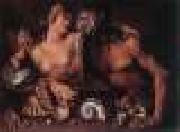 |
GHEYN, Jacob de II
|
|
Dutch engraver/painter (b. 1565, Antwerp, d. 1629, The Hague).
was a Dutch painter and engraver, whose work shows the transition from Northern Mannerism to Dutch realism over the course of his career. De Gheyn received his first training from his father, Jacob de Gheyn I, a glass painter, engraver, and draftsman. In 1585, he moved to Haarlem, and studied under Hendrik Goltzius for the next five years. He moved again to Leiden in the middle of the 1590s. His first commission was for an engraving of the Siege of Geertruitenberg from Amsterdam city officials in 1593. Around 1600, de Gheyn abandoned engraving, and focused his work on painting and etching. Moving to The Hague in 1605, he was employed often by Dutch royalty, designing a garden in the Buitenhof for Prince Maurice of Orange which featured the two first grottoes in the Netherlands. After Prince Maurice's death in 1625, de Gheyn worked for Prince Frederick Henry, his brother. De Gheyn painted some of the earliest female nudes, vanitas, and floral still lifes in Dutch art. He is credited with creating over 1,500 drawings, including landscapes and natural history illustrations. |
|
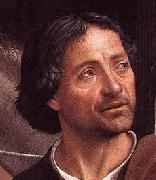 |
GHIRLANDAIO, Domenico
|
|
Italian Early Renaissance Painter, 1449-1494
Florentine painter, whose family name was Bigordi. He may have studied painting and mosaics under Alesso Baldovinetti. Ghirlandaio was an excellent technician. Keenly observant of the contemporary scene, he depicted many prominent Florentine personalities within his religious narrative paintings. Among his earliest frescoes are the Madonna with the Vespucci Family and the Last Supper (Church of the Ognissanti, Florence). He painted scenes from the life of Santa Fina (collegiate church in San Gimigniano) and frescoes in the Palazzo Vecchio, Florence. In 1481, Pope Sixtus IV called him to Rome, along with Botticelli, to decorate the Sistine Chapel. He painted the Calling of the First Apostles, a scene close in spirit to Masaccio. He returned to Florence to work on the frescoes in the Sassetti Chapel in Santa Trinita. He introduced Sassetti, Corsi, Poliziano, the Medici, and many other contemporaries as participants in the life of St. Francis. Ghirlandaio's most famous achievement is his fresco cycle of the life of Mary and St. John the Baptist for the choir of Santa Maria Novella. Michelangelo served an apprenticeship with him at this time and probably worked on these frescoes. Other examples of his art are the Adoration of the Magi (Uffizi); another Adoration (Hospital of the Innocents); a mosaic of the Annunciation for the Cathedral; a portrait of Francesco Sassetti and his son (Metropolitan Mus.);
|
|
|
|
|
|
|
|
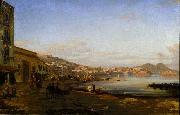 |
Giacinto Gigante
|
|
(1806-1876) was an Italian painter. Gigante was introduced to painting by his father Gaetano Gigante.
His brothers Achille Gigante and Ercole Gigante also became landscape artists. He trained in the style of Hackert and was influenced by the technical drawing carried out at the Naples Royal Institute of Fine Arts.
Along with Achille Vianellihe was to be strongly influenced by a large colony of foreign painters then present in Naples including Huber and Pitloo. From Wolfgang Huber Gigante learnt watercolour technique and the use of the panoramic ?-amera lucidae method. Via Huber he met the Dutch artist Anton Sminck van Pitloo, who became his teacher for a few years. In 1823 Gigante won the Naples Royal Institute of Fine Arts drawing competition. In 1826 he displayed four works at the first Esposizione di Belle Arti. Reportedly though Gigante did not fit in well with the life of the Naples Royal Institute of Fine Arts and left.
Around 1826 he was living in Naples in Vicoletto del Vasto 15, with Van Pitloo, Carl Götzloff and Teodoro Duclere.
He is considered the foremost exponent of the 19th-century Neapolitan "Posillipo School" of painting.
|
|
|
|
 |
giacomo balla
|
|
Balla is often portrayed as a painter closely associated with Italian Futurism although in fact, like a number of others associated with the group, his work crossed into a number of creative disciplines including fashion and the applied arts. In 1914 he wrote the Manifesto on Menswear, later retitled Antineutral Clothing, a dramatic exhortation to dispense with the mundaneity of everyday menswear in favour of dynamic, expressive, and aggressive Futurist clothing. Like his fellow Futurists he sought to sweep away all vestiges of Italy cultural heritage in favour of an emphatically 20th-century way of life. He conceived of Futurist menswear as allowing its wearers to respond to mood changes through pneumatic devices that can be used on the spur of the moment, thus everyone can alter his dress according to the needs of his spirit. It could also be animated by electric bulbs. He had an exhibition at the Casa DArte Bragaglia in Rome in 1918, in conjunction with which he co-published his Colour Manifesto. He was also committed to Futurist applied arts and furniture, brightly painted and with richly animated surfaces, and showed them at his Futurist House in 1920, the year in which he collaborated on the journal Roma futurista. He also exhibited at the Paris Exposition des Arts D??coratifs et Industriels of 1925 and the International Exhibition at Barcelona in 1929. However he failed to get his Futurist designs put into mass production and during the 1930s gradually distanced himself from such an outlook. |
|
|
|
|
|
 |
Giacomo Di Chirico
|
|
Giacomo Di Chirico (25 January 1844 - 26 December 1883) was an italian painter. Together with Domenico Morelli and Filippo Palizzi, he was one of the most elite Neapolitan artists of the 19th century. He received the official title eKnight of Italye from King Victor Emmanuel II.
|
|
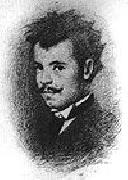 |
Giacomo Favretto
|
|
Abbandonata la bottega di falegname paterna, frequenti dal 1864 l'Accademia di Belle Arti di Venezia, dove le lezioni impartitegli misero in luce le qualita innate di pittore, evidenziate in una delle sue opere maggiori La lezione di anatomia (1873).
Nel 1878 compi un viaggio a Parigi insieme a Guglielmo Ciardi. Il viaggio fu determinante per l'evoluzione della sua arte, come tecnica e come soggetti (non solo scene di intimita familiare ma anche soggetti in costume settecentesco). Riscosse un ottimo successo, si fece conoscere a livello internazionale e assimilo una certa tendenza al manierismo.
Del 1880 e l'opera Vandalismo, premiata a Brera, dove fu esposta ed e attualmente conservata. In queste opere l'artista si converti verso un'animazione realistica, un uso della coloristica controllato, un grande dispiego inventivo e una delicatezza tonale.
Negli ultimi anni le opere del Favretto assunsero una sempre crescente luminosita ed una struttura sempre piu naturalistica.
Mori nel 1887, durante l'Esposizione nazionale artistica tenutasi nella citta lagunare, nella quale l'artista esponeva Il Liston. |
|
 |
Giacomo Francesco Cipper
|
|
(Feldkirch, 1664 - Milan, 1736) was a German painter active in Milan from 1696 to 1736.
Of German origin, he was active in Milan in the first half of the 18th century. Fertile painter of scenes of kind of formulation caravaggesca, his first attributed work is dated 1700; he operated in Lombardia and in Veneto ( Hunters and greengrocers , Modena, Gallery Campori; Farmers' family , Venice, Galleries of the academy). Subsequently the artist, perhaps under the influence of the Cerruti (some of whose works were once attributed to Cipper), to the scrupulous surrender of the detail it replaced a less illustrative vision, more sensitive to the games of light.
His last known work is Self-portrait (1736, Hampton Court).
|
|
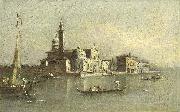 |
Giacomo Guardi
|
|
(1764-1835) was an Italian painter from Venice. The son of famous veduta painter Francesco Guardi, he continued his father's line of work, though without the same level of renown. The majority of his works are quite small views of only minor artistic interest, more akin to postcards than to his father's grand scenes, but he produced several paintings showcasing a notable level of artistic skill as well. Evaluating his legacy is somewhat complicated due to the frequency with which paintings are misattributed to him. |
|
 |
Giambattista Moroni
|
|
Albino(near Bergamo 1520/25-Bergamo 1578
Italian painter. He was the most significant painter of the 16th-century school of Bergamo and is best known for his portraits, which feature a naturalistic rendering of both faces and costume and an objective approach to character. |
|
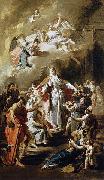 |
Giambattista Pittoni
|
|
(1687?C1767) was an Italian painter of the late-Baroque or Rococo period, active mainly in his native Venice.
Pittoni is best known for his "grand-manner" canvases depicting religious, historical, and mythological subjects (such as Sophonisba and Polyxena). He was a co-founder of the official painter's academy in Venice (in competition to the old fraglia or painter's guild), the Accademia di Belle Arti di Venezia, and he succeeded as President (1758?C1761) his contemporary Giovanni Battista Tiepolo. Pittoni never left his native Venice, but completed commissions from German, Polish, Russian, and Austrian patrons. His mature palette was noted, as was Tiepolo's, for his lightness of tone. Besides Tiepolo, Pittoni's influences were Giovanni Battista Piazzetta, Sebastiano Ricci, and Antonio Balestra. His paintings were of a Rococo style, but later became more sedate in their approach towards Neoclassicism.
|
|
 |
Giambattista Tiepolo
|
|
1696-1770
Italian painter, master of Venetian school. Tiepolo was famous in his own lifetime as a superb painter in fresco and a brilliant draftsman. A highly inventive artist, he could create spectacular effects in difficult sites, from the narrow gallery at the patriarchal palace at Udine in the mid-1720s to the vast staircase ceiling in the Residenz at Werzburg in the early 1750s. Contemporaries recognized his spirited, dynamic approach to subject matter and his frankly sensuous manner of painting. Tiepolo is comparable in his restless energy and imaginative power to Peter Paul Rubens, and essentially he worked with a similar baroque language of myth, allegory, and history, which he infused with a sense of freshness and modernity. His approach to religious art is characterized by candor and naturalism, while he was responsive to the different concerns of patrons and viewers at a time when the church was faced with new kinds of devotion and criticism. With the advent of neoclassicism, Tiepolo's art fell from favor: In an age that prized archaeological correctness, rationality, and ideals of improvement, his witty, Veronese-inspired conception of historical or classical subjects seemed frivolous, while his visually seductive qualities were seen as inimical to the serious intellectual aims of the new art. Nevertheless, his drawings and oil sketches continued to appeal to collectors, including Antonio Canova. The son of a Venetian shipping merchant, Tiepolo was apprenticed in 1710 to Gregorio Lazzarini (1655C1730), an artist of international reputation patronized by prominent Venetian families. Before becoming an independent master, he worked in the household of Doge Giovanni Corner; members of the Corner family were to be his most steadfast and liberal patrons. Lazzarini encouraged his pupils to study Venetian sixteenth-century art, and Tiepolo made drawings of some famous works for publication in Domenico Lovisa's Gran Teatro di Venezia of 1717. His early involvement with the thriving Venetian engraving and publishing world was renewed in 1724 when he made drawings of antique sculpture as illustrations for Scipione Maffei's Verona Illustrata, an experience that gave Tiepolo an imaginative empathy with fragmentary antique remains, which recur in his drawings, etchings, and paintings. As well as studying the art of the past, Tiepolo looked to the tenebrism of Federico Bencovich (1677C1753) and the realism and monumentality of Giovanni Battista Piazzetta (1682C1754). In 1719 Tiepolo married Cecilia Guardi, with whom he was to have nine children. By then, the artist was working for a network of mercantile and noble patrons on religious and secular subjects. |
|
|
|
|
|
|
|
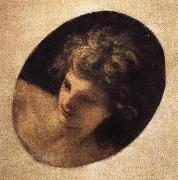 |
Gian Lorenzo Bernini
|
|
Italian sculptor , b. 1598, Napoli, d. 1680, Roma
,Italian architect and artist credited with creating the Baroque style of sculpture. He began his career working for his father, a sculptor. Among his early sculptures are Apollo and Daphne (1622 -C 24) and an active David (1623 -C 24). Under the patronage of Urban VIII, the first of eight popes he was to serve, he created the baldachin over the tomb of St. Peter in Rome. Bernini's architectural duties increased after 1629, when he was appointed architect of St. Peter's Basilica and the Palazzo Barberini. His works often represent a fusion of architecture and sculpture, as in the Cornaro Chapel, in Santa Maria della Vittoria, Rome, with its celebrated theatrical sculpture, The Ecstasy of St. Teresa (1645 C 52). His greatest architectural achievement is the colonnade enclosing the piazza before St. Peter's. |
|
|
|
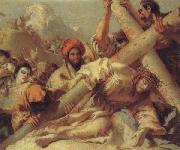 |
Giandomenico Tiepolo
|
|
Italian Rococo Era Painter , Venice 1727 - 1804
was a painter and printmaker in etching, son of artist Giovanni Battista Tiepolo and elder brother of Lorenzo Baldissera Tiepolo. Domenico was born in Venice, studied under his father, and by the age of 13 was the chief assistant to him. He was one of the many assistants, including Lorenzo, that transferred the designs of his father (executed in the 'oil sketch' invented by the same). By the age of 20, he was producing his own work for commissioners. He assisted his father in Werzburg 1751-3, decorating the famous stairwell fresco, in Vicenza at the Villa Valmarana in 1757, |
|
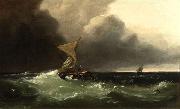 |
Gideon Jacques Denny
|
|
(1830-1886) was a marine artist who was born in Wilmington, Delaware on July 15, 1830. As a young man, he worked on ships in the Chesapeake Bay. He traveled to California in 1849 with the Gold Rush. He worked as a teamster on the San Francisco docks and was a member of the San Francisco Committee of Vigilance. After two years in California, he moved to Milwaukee, where he studied painting with Samuel Marsden Brookes. After six years of study in Milwaukee, Denny returned to San Francisco and established a studio on Bush Street. In 1862, Brooks moved to San Francisco and shared a studio with Denny. In 1868, Denny spent two months in Hawaii visiting several islands. He is also known to have visited Canada and South America. Denny died of malaria in Cambria, California on Oct. 7, 1886.
The Berkeley Art Museum and Pacific Film Archive, the Bishop Museum (Honolulu), the Crocker Art Museum (Sacramento, California), the Fine Arts Museums of San Francisco, Monterey Peninsula Museum of Art, and the Oakland Museum of California are among the public collections holding works by Gideon Jacques Denny.
|
|
 |
Gigo Gabashvili
|
|
(November 9, 1862 - October 28, 1936) was a Georgian painter and educator. His work was particularly influential since he was the first Georgian realistic artist to cover a wide range of subjects, both in oils and watercolor, including portraits, landscapes and scenes of everyday life.
Born in Tbilisi, Georgia (then part of the Russian Empire), Gigo Gabashvili was educated at the academies of St. Petersburg (1886 - 1888) and Munich (1894 - 1897). Returning to his homeland, he made his debut as the first artist to have been honored with a personal exhibition in Tbilisi. From 1900 to 1920, he taught at the art school operated by the Caucasian Society for Promotion of Fine Arts. Gabashvili was one of the founding professors of the Tbilisi State Academy of Arts (1922) and was granted the title of the People's Artist of the Georgian SSR (1929). Gabashvili remained a staunch realist and made known his opposition to left-wing art. He died in Tsikhisdziri, Adjara, in 1936. He is best known for his series of vivid portraits of peasants, townsmen, and noblemen ("The Three Townsmen", 1893; "The Sleeping Khevsur", 1898; "The Drunk Khevsur", 1899; "A Kurd", 1903 - 1909; "The Three Generals", 1910; etc.) as well as multifigure scenes from Georgian ("Alaverdoba Festival", 1899) and Oriental life - many of them based on the sketches of his Central Asian journey in 1894 ("The Bazaar in Samarkand", 1894 - 1897; "The Divan-Bey Pool in Bukhara", 1897; etc.). Most of his works are now on display at the National Museum of Fine Arts in Tbilisi. His 1895 copy of "The Bazaar in Samarkand," created at the request of the U.S. diplomat and businessman Charles R. Crane who met him during his travel in the Caucasus, was sold for USD 1.36 million at Sotheby's in 2006.
|
|
|
|
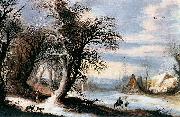 |
Gijsbrecht Leytens
|
|
(1586-1643 or 1656), also known as The Master of the Winter Landscapes, was a Flemish Baroque painter who specialized in winter landscapes influenced by Jan Brueghel the Elder and Gillis van Coninxloo. He became a master in Antwerp's guild of St. Luke in 1611, but little else is known of his career. Like his contemporaries in Antwerp, Abraham Govaerts and Alexander Keirincx, Leytens painted wooded landscapes populated with small figures, bracketed by strong repoussoir trees. His paintings, however, were generally winter scenes, a recognized specialty known as a Winterken ("little winter"). |
|
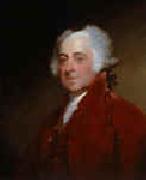 |
Gilbert Charles Stuart
|
|
1755-1828
Gilbert Charles Stuart Locations
Gilbert Charles Stuart (born Stewart) (December 3, 1755 ?C July 9, 1828) was an American painter from Rhode Island.
Gilbert Stuart is widely considered to be one of America's foremost portraitists. His best known work, the unfinished portrait of George Washington that is sometimes referred to as The Athenaeum, was begun in 1796 and left incomplete at the time of Stuart's death in 1828. The image of George Washington featured in the painting has appeared on the United States one-dollar bill for over one century.
Throughout his career, Gilbert Stuart produced portraits of over 1,000 people, including the first six Presidents of the United States. His work can be found today at art museums across the United States and the United Kingdom, most notably the Metropolitan Museum of Art in New York City, the National Gallery of Art in Washington, D.C., the National Portrait Gallery in London, and the Museum of Fine Arts in Boston. |
|
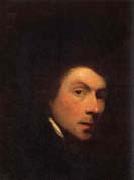 |
Gilbert Stuart
|
|
1755-1828
Gilbert Stuart was born in North Kingston, R.I., on Dec. 3, 1755. At the age of 13 or 14 he studied art with the Scottish painter Cosmo Alexander in Newport. With Alexander he made a tour of the South and a journey to Edinburgh, where Alexander died in 1772. For about a year Stuart remained, poverty-stricken, in Scotland, but finally, working as a sailor, he managed to get back to America. There he executed a few portraits in a hard limner fashion. With the Revolutionary War threatening, his family, who had Tory sympathies, fled to Nova Scotia, and Stuart sailed for London, where he remained from 1775 to 1787. For the first 4 or 5 years, Stuart served as the first assistant of American expatriate painter Benjamin West, who had rescued him from poverty. From the first, Stuart showed an interest only in portraiture and had no desire to go into the branch of history painting West practiced. After his apprenticeship, Stuart became London's leading portrait painter, next to Joshua Reynolds and Thomas Gainsborough, whose style he emulated, as in a rare full-length portrait of William Grant of Congalton as The Skater (ca. 1782). For a while Stuart lived in splendor, but being a bad businessman and a profligate spender, he was in constant debt. He lived in Ireland from 1787 to 1792 and then returned to America to make a fortune, |
|
|
|
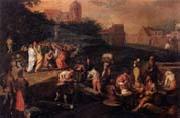 |
Gillis Mostaert
|
|
Flemish Northern Renaissance Painter ,
b. ca. 1534, Hulst, d. 1598, Antwerp |
|
|
|
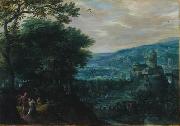 |
Gillis van Coninxloo
|
|
(1544 ?C 1607) was a Dutch painter of forest landscapes, the most famous member of a large family of artists. He travelled through France, and lived in Germany for several years to avoid religious persecution.
He was born at Antwerp and studied under Pieter Coecke van Aelst, Lenaert Kroes and Gillis Mostaert. He practiced his art in France, but in 1587, on account of religious persecution, emigrated to Frankenthal and passed his later life in Amsterdam, where he died in 1607.
Coninxloo ranks as one of the most important Dutch landscape painters of the transition from the sixteenth to the seventeenth century. He exercised a strong influence on Jan Brueghel the Elder, Schoubroeck, Savery, and other Flemish and Dutch landscape painters of the transition period. Coninxloo is considered the founder of a new approach to the painting of forests; while earlier forest landscapes had used woods as backdrops for human activity, van Coninxloo made them a subject, submerging tiny human figures in elaborate compositions of trees in hugely exaggerated scale.
During his stay at Frankenthal from 1588 to 1595, he influenced several better known Dutch landscape-painters collectively referred to as the Frankenthal School. Karel van Mander wrote about him and his father Jan den Hollander in his Schilder-boeck. He wrote that his teacher Pieter Coeke van Aelst was his cousin, and that his landscapes were among the best of all Dutch landscape artists.
|
|
|
|
 |
GILLOT, Claude
|
|
French Painter, 1673-1722
French draughtsman, printmaker and painter. He was the son of an embroiderer and painter of ornaments, who doubtless trained him before he entered the Paris studio of Jean-Baptiste Corneille about 1690; there he learnt to paint and etch. In 1710 he was approved by the Academie Royale; he was received as a history painter five years later, on presentation of the Nailing of Christ to the Cross . Although he painted other elevated subjects, including a Death of the Virgin (1715; untraced) for his native Langres, he was most active as a draughtsman and printmaker specializing in theatre and genre scenes, as well as bacchanals and designs for decorations. Gillot's principal source of inspiration was the popular theatre; he is said to have run a puppet theatre, to have written plays and once to have been in charge of sets, machinery and costume for the opera. This interest was to have a profound effect on the art of his principal pupil, Antoine Watteau |
|
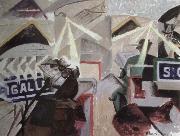 |
gino severini
|
|
gino severini (1883 to 1966),Italian painter, mosaicist, stage designer and writer. One of the principal exponents of Futurism, he was an important link between French and Italian art. Although his most historically significant works were produced before World War I, he had a long career during which he continued to evolve his style, particularly in abstract schemes. |
|
 |
Gioacchino Assereto
|
|
(1600 - 28 June 1649) was an Italian painter of the early Baroque period, active in Genoa.
Gioacchino Assereto, David with the Head of Goliath.He initially apprenticed with Luciano Borzone and later Giovanni Andrea Ansaldo. He painted two vault frescoes in the church of Santissima Annunziata del Vastato: David and Abimelech and Santi Giovanni and Pietro healing the lame. He also shows the influence of Bernardo Strozzi, a tenebrism moderated by venetian coloristic effects and garbing the subjects in modern peasant garb, in paintings such as Moses obtaining water from the Rock (Prado Museum, Madrid). Orazio dee Ferrari may have worked with Assereto in Ansaldoes studio.
Paintings by Gioacchino Assereto can also be seen at the Detroit Institute of Art and the Museum of Fine Arts in Budapest,Hungary.
|
|
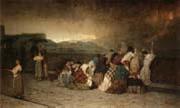 |
Gioacchino Toma
|
|
Italian , Galatina 1836 - Napoli 1891
Italian painter. He was orphaned at the age of six and spent an unhappy childhood and adolescence in convents and poorhouses; these experiences would later provide subjects for his paintings. He was first taught drawing at the art school in the hospice for the poor in the Adriatic town of Giovinazzo, but in 1855 he moved to Naples, where he worked for an ornamental painter named Alessandro Fergola. In 1857 he was mistakenly arrested for conspiracy and exiled to Piedimonte d'Alife, 60 km from Naples, where he was initiated into the secret society of the Carbonari by some local liberal aristocrats who also became his first patrons. His paintings for them were mainly still-lifes, largely in the traditional Neapolitan style. On his return to Naples in 1858 he became a student at the Accademia di Belle Arti, attending the classes of Domenico Morelli, who influenced such early works as Erminia (1859; Naples, Pal. Reale). Toma fought for two years with Garibaldi in the campaign for the unification of Italy, then returned to painting, |
|
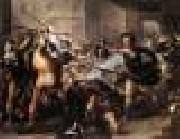 |
GIORDANO, Luca
|
|
Italian Baroque Era Painter, ca.1634-1705
,Italian painter and draughtsman, active also in Spain. He was one of the most celebrated artists of the Neapolitan Baroque, whose vast output included altarpieces, mythological paintings and many decorative fresco cycles in both palaces and churches. He moved away from the dark manner of early 17th-century Neapolitan art as practised by Caravaggio and his followers and Jusepe de Ribera, and, drawing on the ideas of many other artists, above all the 16th-century Venetians and Pietro da Cortona, he introduced a new sense of light and glowing colour, of movement and dramatic action. |
|
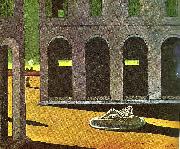 |
giorgio de chirico
|
|
Giorgio de Chirico (Italian pronunciation: [ˈdʒɔrdʒo deˈkiriko]; July 10, 1888 ?C November 20, 1978) was a pre-Surrealist and then Surrealist Italian painter born in Volos, Greece, to a Genoese mother and a Sicilian father. He founded the scuola metafisica art movement. His surname is traditionally written De Chirico (capitalized De) when it stands alone |
|
|
|
|

